 W
WBulgarian cuisine is a representative of the cuisine of Southeast Europe. It shares characteristics with other Balkan cuisines. Bulgarian cooking traditions are diverse because of geographical factors such as climatic conditions suitable for a variety of vegetables, herbs, and fruit. Aside from the vast variety of local Bulgarian dishes.
 W
WAjvar is a condiment made principally from sweet bell peppers and eggplants. The relish became a popular side dish throughout Yugoslavia after World War II and is popular in Southeast Europe.
 W
WBob chorba is a chorba, a Bulgarian soup. It is made from dry beans, onions, tomatoes, chubritza or dzhodzhen (spearmint) and carrots.
 W
WBorek or burek is a filled pastry made of a thin flaky dough such as filo with a variety of fillings, such as meat, cheese, spinach or potatoes. Boreks are mainly associated with the areas of the former Ottoman Empire, including the Balkans and the Caucasus, the Middle East, Eastern European and Central European countries, Northern Africa and Central Asia. A borek may be prepared in a large pan and cut into portions after baking, or as individual pastries. They are usually baked but some varieties can be fried. Borek is sometimes sprinkled with sesame or nigella seeds, and they may be served hot or cold.
 W
WA cabbage roll is a dish consisting of cooked cabbage leaves wrapped around a variety of fillings. It is common to the cuisines of Central, Northern, Eastern and Southeastern Europe and much of Western Asia, Northern China, as well as parts of North Africa. Meat fillings are traditional in Europe, and include beef, lamb, or pork seasoned with garlic, onion, and spices. Grains such as rice and barley, mushrooms, and vegetables are often included as well. Fermented cabbage leaves are used for wrapping, particularly in southeastern Europe. In Asia, seafoods, tofu, and shiitake mushrooms may also be used. Chinese cabbage is often used as a wrapping.
 W
WĆevapi, ćevapčići is a grilled dish of minced meat found traditionally in the countries of southeast Europe. It is considered a national dish of Bosnia and Herzegovina, and is also common in Serbia, Croatia, Montenegro, Kosovo, North Macedonia and Slovenia.
 W
WChushkopek is a uniquely Bulgarian kitchen appliance for roasting peppers, aubergines or potatoes, generally used in salads.
 W
WÇılbır is a Turkish dish of poached eggs with yogurt.
 W
WChorba or shorba, refers to several kinds of soup or stew found in national cuisines across the Balkans, Central Europe, Eastern Europe, Central Asia, Middle East and the Indian subcontinent. It is often prepared with added ingredients but served alone as a broth or with bread.
 W
WCozonac or Kozunak is a special sweet leavened bread, traditional to Southeastern Europe, Romania, Bulgaria and Serbia, Macedonia, Greece, etc. Rich in eggs, milk and butter, it is usually prepared for Easter in Romania, Serbia, Bulgaria, and mostly for every major holiday in Romania and Moldova. The name comes from the Greek word for hair-коса/kosa, or Greek: ϰοσωνάϰι kosōnáki, a diminutive form of ϰοσώνα kosṓna.
 W
WFisherman's soup or halászlé is a hot, spicy paprika-based fish soup. A folk item of Hungarian cuisine, it is a bright-red hot dish prepared with generous amounts of hot paprika and carp or mixed river fish. It is native to the Pannonian Plain, particularly the Danube and Tisza river regions. It is also a popular dish among ethnic German Donauschwaben and their descendants, known as Karpfensuppe.
 W
WGarash is a type of chocolate cake in Bulgarian cuisine. It is commonly found in Bulgarian patisseries and restaurants.
 W
WGüveç is a family of earthenware pots used in Balkan, Turkish, and Levantine cuisine, and various casserole or stew dishes cooked in them. The pot is wide and medium-tall, can be glazed or unglazed, and the dish in it is cooked with little or no additional liquid.
 W
WHalva refers to various local confection recipes. The name is used for referring to a huge variety of confections, with the most geographically common variety based on toasted semolina.
 W
WHead cheese or brawn is a cold cut terrine or meat jelly, often made with flesh from the head of a calf or pig, typically set in aspic, that originated in Europe. Usually eaten cold, at room temperature, or in a sandwich, the dish is, despite the name, not a dairy cheese. The parts of the head used in the dish vary, though commonly do not include the brain, eyes or ears of the animal. The tongue, and sometimes the feet and heart of the animal may be included; the dish is also made using trimmings from more commonly eaten cuts of pork and veal, with the addition of gelatin as a binding agent. Head cheese may also be made without using the flesh from the head of an animal.
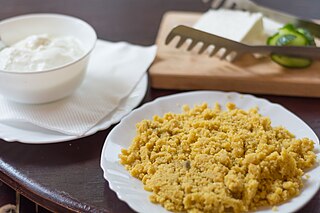 W
WKačamak is a kind of maize porridge made in parts of Western Asia and Southeastern Europe. Its name is derived from the Turkish word kaçamak, meaning escapade. It is also known as bakrdan (бакрдан) in North Macedonia.
 W
WKapuska is a hearty traditional Turkish cuisine and Balkan cuisine stew whose name is derived from the Slavic languages word for cabbage. Although the name is imported, the dish is a Turkish version of a cabbage stew common in Russia, Ukraine, Poland and other countries of Eastern Europe. Kapuska is widely known and consumed in the Thrace and Black Sea regions of Turkey.
 W
WKebapche is a Bulgarian dish of grilled minced meat with spices. The meat is shaped into an elongated cylindrical form, similar to a hot dog. Typically, a mix of pork and beef is used, although some recipes involve only pork. The preferred spices are black pepper, cumin and salt. Kebapche is a grilled food. It is never fried or baked.
 W
WKhash is a dish of boiled cow or sheep parts, which might include the head, feet, and stomach (tripe).
 W
WKoliva, also spelled kollyva, kollyba or colivă, is a dish based on boiled wheat that is used liturgically in the Eastern Orthodox Church for commemorations of the dead.
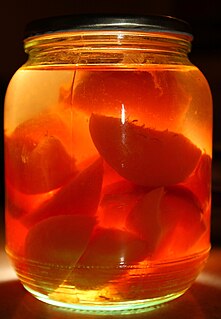 W
WKompot or compote is a non-alcoholic sweet beverage that may be served hot or cold, depending on tradition and season. It is obtained by cooking fruit such as strawberries, apricots, peaches, apples, raspberries, rhubarb, plums, or sour cherries in a large volume of water, often together with sugar or raisins as additional sweeteners. Sometimes different spices such as vanilla or cinnamon are added for additional flavour, especially in winter when kompot is usually served hot. Kompot is popular in Central and Eastern European countries as well as in Southern Europe.
 W
WThe korovai, karavai, or kravai is a traditional Bulgarian, Ukrainian, Romanian and Russian bread, most often used at weddings, where it has great symbolic meaning, and has remained part of the wedding tradition in Belarus, Russia, Ukraine and by the Russian and Ukrainian diasporas. Its use in Belarus, Russia and Ukraine dates back to hospitality and holiday customs in ancient Rus. Round korovai is a common element of the bread and salt ceremony.
 W
WKyopolou is a popular Bulgarian and Turkish spread, relish and salad made principally from roasted eggplants and garlic.
 W
WLjutenica, lyutenitsa or lutenica is a vegetable relish or chutney in Bulgarian, Macedonian and Serbian cuisines.
 W
WMish-mash is a Bulgarian spring dish made with fresh vegetables, eggs and Sirene often garnished with freshly cut parsley. There are variations in which garlic, scallions, eggplants, okras or carrots are added to the dish. There are variations without sirene and without onion as well.
 W
WNettle soup is a traditional soup prepared from stinging nettles. Nettle soup is eaten mainly during spring and early summer, when young nettle buds are collected. Today, nettle soup is mostly eaten in Scandinavia, Iran, Ireland, and Eastern Europe, with regional differences in recipe; however historically consumption of nettles was more widespread.
 W
WNokul or lokum is a type of puff pastry. Nokul is a type of pastry eaten in Turkey and Bulgaria with variations. Nokul is sometimes served hot as an appetizer instead of bread. It consists of a rolled sheet of yeast dough onto which feta-style white cheese, walnut or poppy seed is sprinkled over a thin coat of butter. The dough is then rolled, cut into individual portions, and baked.
 W
WPalatschinke is a thin crêpe-like variety of pancake of Greco-Roman origin. While the dessert is most common in South and West Slavic countries, it is also generally known in other parts of Central and Eastern Europe. Names of the dish include Palaçinka (Albanian), Palatschinke, palačinka, palacinka (Slovak), palačinka (Czech), палачинка, naleśnik (Polish), clătite (Romanian), palacinta or palacinca (Italian) and palacsinta (Hungarian).
 W
WPanagyurishte style eggs is a popular Bulgarian dish that is made with poached eggs, Bulgarian yoghurt and sirene, and is eaten warm, often for lunch.
 W
WPaprika is a spice made from dried and ground red peppers. It is traditionally made from Capsicum annuum varietals in the Longum group, which also includes chili peppers, but the peppers used for paprika tend to be milder and have thinner flesh. In some languages, but not English, the word paprika also refers to the plant and the fruit from which the spice is made, as well as to peppers in the Grossum group.
 W
WPatatnik or patetnik is a Bulgarian potato dish characteristic of the Rhodope Mountains in the country's central south. Patatnik is made of grated potatoes, onions, salt and a type of very mild mint called Gyosum in Bulgarian, all mixed and cooked on a slow fire. Some restaurants add sirene or eggs, but this is not traditional; some people also use savory and peppers.
 W
WPierogi are filled dumplings made by wrapping unleavened dough around a savoury or sweet filling and cooking in boiling water. They are often pan-fried before serving.
 W
WPig slaughter is the work of slaughtering domestic pigs which is both a common economic activity as well as a traditional feast in some European and Asian countries.
 W
WPig's ear, as food for human consumption, is the cooked ear of pig. It is found in a number of ciusines around the world.
 W
WPindjur or pinjur or pinđur is a relish form and is commonly used as a summer spread. Pindjur is commonly prepared in Bosnia and Herzegovina, Bulgaria, Serbia and North Macedonia.
 W
WPogača is a type of bread baked in the ashes of the fireplace, and later on in the oven, similar to focaccia. found in the cuisines of the Balkans, and Turkey. It can be leavened or unleavened, but only experienced cooks can make good-quality unleavened pogača, while the pastry with yeast is easier to make. It is generally made from wheat flour, but barley and sometimes rye may be added. It can be stuffed with potatoes, ground beef, or cheese, and have grains and herbs like sesame, black nigella seed, or dried dill in the dough or sprinkled on top.
 W
WPolenta is a dish of boiled cornmeal that was historically made from other grains. It may be served as a hot porridge, or it may be allowed to cool and solidify into a loaf that can be baked, fried, or grilled.
 W
WPopara is a dish made with bread. It is mostly made in Bulgaria, Greece, Serbia, Bosnia and Herzegovina, North Macedonia, Turkey and Montenegro.
 W
WPunjena paprika is a Balkan dish made of peppers, stuffed with a mix of meat and rice in tomato sauce, the ingredients consisting of green or red capsicums, eggs, spices, salt, tomato, minced meat and rice. It is particularly popular in Southeast Europe.
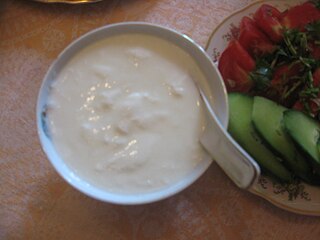 W
WQatiq is a fermented milk product from the Turkic countries. It is considered a more solid form of yogurt than ayran.
 W
WSarma, commonly marketed as stuffed grape leaves, is a type of dolma—a stuffed dish of the cuisines of the former Ottoman Empire from the Middle East to Southeastern Europe—comprising grapevine, cabbage, monk's rhubarb, kale or chard leaves rolled around a filling of grains, minced meat, or both.
 W
WSharena sol, also known as colourful salt, is a spice mix used extensively in Bulgarian cuisine. Its most typical ingredients are dried summer savoury, paprika and salt. In addition, dried fenugreek leaves are frequently added and thyme is not uncommon.
 W
WShopska salad, is a Bulgarian cold salad popular throughout Southeastern Europe. This is Bulgaria's most famous dish and national salad. The ingredients used were chosen in part because they resemble the three colors of the Bulgarian flag, and thus would evoke a national sentiment.
 W
WSlatko is a thin fruit preserve made of fruit or rose petals in Bulgarian, Macedonian, and Serbian cuisine. Almost any kind of fruit can be used, like wild strawberry, blueberry, plum and cherry. Slatko is used as a topping for ice cream and waffle shortcakes, and as a filling in pancakes.
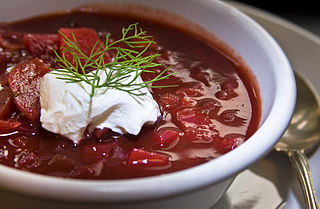 W
WSmetana is a type of sour cream from Central and Eastern Europe. It is a dairy product produced by souring heavy cream. It is similar to crème fraîche, but nowadays mainly sold with 9% to 42% milkfat content depending on the country. Its cooking properties are different from crème fraîche and the lighter sour creams sold in the US, which contain 12 to 16% butterfat. It is widely used in cooking and baking.
 W
WSnezhanka salad or Snow White salad is a traditional Bulgarian salad, which is made of strained yogurt, cucumber, garlic, salt, usually cooking oil, dill, sometimes roasted peppers, walnuts and parsley. Sometimes it is called milk salad or dry tarator salad.
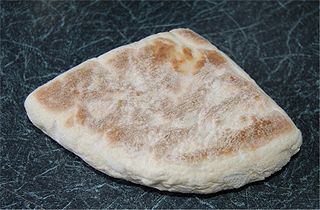 W
WSoda bread is a variety of quick bread traditionally made in a variety of cuisines in which sodium bicarbonate is used as a leavening agent instead of the traditional yeast. The ingredients of traditional soda bread are flour, baking soda, salt, and buttermilk. The buttermilk in the dough contains lactic acid, which reacts with the baking soda to form tiny bubbles of carbon dioxide. Other ingredients can be added, such as butter, egg, raisins, or nuts. An advantage of quick breads is their ability to be prepared quickly and reliably, without requiring the time-consuming skilled labor and temperature control needed for traditional yeast breads.
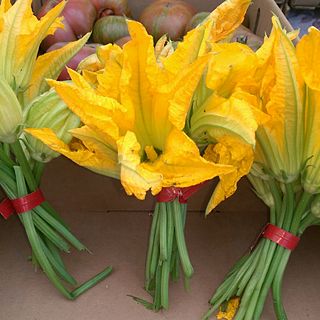 W
WSquash blossoms are the edible flowers of Cucurbita species, particularly Cucurbita pepo, the species that produces zucchini (courgette), marrow, spaghetti squash, and many other types of squash.
 W
WSujuk or sucuk is a dry, spicy and fermented sausage which is consumed in several Balkan, Middle Eastern and Central Asian cuisines. Sujuk mainly consists of ground meat and animal fat usually obtained from beef or lamb, but horse meat is also often used in Bulgaria, Kazakhstan and Kyrgyzstan.
 W
WSummer savory is among the best known of the savory genus. It is an annual, but otherwise is similar in use and flavor to the perennial winter savory. It is used more often than winter savory, which has a slightly more bitter flavor.
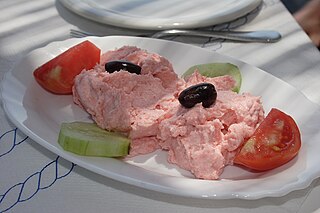 W
WTaramasalata or taramosalata is a meze made from tarama, the salted and cured roe of the cod, carp, or grey mullet (bottarga) mixed with olive oil, lemon juice, and a starchy base of bread or potatoes, or sometimes almonds. Variants may include garlic, spring onions, or peppers, or vinegar instead of lemon juice. While not traditionally Greek, smoked rather than cured cod's roe is more widely available in some places, and often used. Bottarga is usually much more expensive than cod's roe.
 W
WTatarsko meatballs, Kofta (Koufteh) is a Bulgarian-Tatar recipe for big meat balls from Bulgaria.
 W
WA torpedo dessert is a buttery, flaky viennoiserie bread roll, filled with pastry cream, named for its well-known torpedo shape. Croissants and other viennoiserie are made of a layered yeast-leavened dough. The dough is layered with butter, rolled and folded several times in succession, then rolled into a sheet, in a technique called laminating. The process results in a layered, flaky texture, similar to a puff pastry.
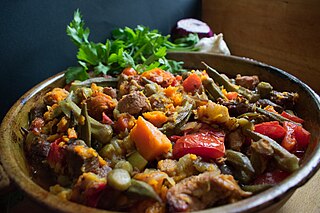 W
WTürlü is a casserole of Turkish cuisine. It is made of stewed vegetables and may also include stewed meat. Varieties of this dish are also found in Balkan cuisines. In particular, it is known as turli perimesh in Albania, tourlou or tourlou tourlou in Greece, and as turli tava in North Macedonia.
 W
WTzatziki, cacık, or tarator is a dip, soup, or sauce found in the cuisines of Southeast Europe and the Middle East. It is made of salted strained yogurt or diluted yogurt mixed with cucumbers, garlic, salt, olive oil, sometimes with vinegar or lemon juice, and herbs such as dill, mint, parsley and thyme. It is served as a cold appetizer (mezze), a side dish, and as a sauce for souvlaki and gyros sandwiches and other foods.
 W
WYakhni, yahni (Turkish), or yahniya is a class of dishes prepared in a vast area from South Asia to the Balkans.
 W
WYogurt also spelled yoghurt, yogourt or yoghourt, is a food produced by bacterial fermentation of milk. The bacteria used to make yogurt are known as yogurt cultures. Fermentation of sugars in the milk by these bacteria produces lactic acid, which acts on milk protein to give yogurt its texture and characteristic tart flavor. Cow's milk is the milk most commonly used to make yogurt. Milk from water buffalo, goats, ewes, mares, camels, yaks and plant milks are also used to produce yogurt. The milk used may be homogenized or not. It may be pasteurized or raw. Each type of milk produces substantially different results.
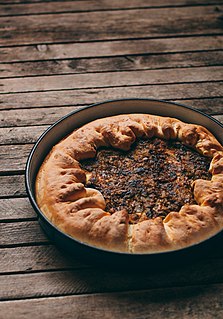 W
WZelnik is a traditional pastry from the Balkans composed of thin layers of phyllo pastry filled with various combinations of sirene, eggs, sorrel, browned meat, leeks and rice. In winter, the filling traditionally includes brined cabbage, from which the dish derives its name: Bulgarian language: "зелe") meaning cabbage. Zelnik is often sometimes served with yoghurt and it is best eaten warm.